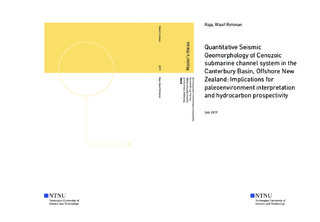| dc.description.abstract | Nowadays, high resolution 3D marine seismic reflection data have allowed to study the morphology of submarine channels (primary conduits to transfer sediment from shelf to the basin) to understand the sedimentary processes and paleoenvironments. However, the interpretation of channels incision or channel isolated amplitude (related to the seismic reflection data resolution) from the 3D marine seismic reflection data poses several challenges due to the presence of data artifacts (e.g. velocity push-downs issues in the study area). The quantitative seismic geomorphology approach, together with traditional seismic interpretation (e.g. interpretation of horizon and fault followed by seismic slicing and seismic attribute analysis) are used in this study to obtain the 3D channels morphometric elements. In addition, regional correlation that utilized 2D seismic reflection and wellbore data providing regional stratigraphy and tectonic information. This study aim to describe architecture and morphometry elements of submarine channels in the Canterbury basin, offshore New Zealand. Thus, sedimentary processes, and paleoenvironment of submarine channel systems in the study area is much more understandable and implication to the hydrocarbon prospectivity could also be described. Submarine channels morphometric parameters such as thalweg (the lowest point of channel base), height, top and base widths, sinuosity, gradient (thalweg), aspect ratio (width/height), and cross-sectional area (CSA) and the relationships among them are measured at an interval of 150-meter perpendicular to the pathways of the channels. Four types of submarine channels are found in the study area based on reflection configuration of channels fills, shape of erosional surfaces, stacking patterns and architectural elements. Furthermore, this thesis work show that channels top width and height vary from proximal to distal part in the context of hundred to thousand meters, respectively. These indicated combination of submarine gravity flow and internal factors (e.g. over-bank collapse, tributaries, etc) in the development of submarine channels system in the study area. In addition, submarine channel system in the study area is also having potential in generating and preserving hydrocarbon. | |
